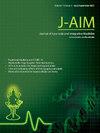由黑云母制成的标准化奎师那金刚阿婆罗卡巴斯玛的毒性概况
IF 1.7
Q3 INTEGRATIVE & COMPLEMENTARY MEDICINE
引用次数: 0
摘要
Bhasmas,草药矿物质,据报道在临床上使用时会产生不良反应。因此,本研究旨在通过急性和亚急性毒性试验来评估 奎师那金刚罗 (KVB)的安全性。材料与方法经伦理委员会批准,选用Wistar白化大鼠66只,体重180 ~ 200 gms。实验按照CCSEA指南进行。在急性 毒性研究中,以蜂蜜加KVB 单极限剂量 2000 mg/kg 给药6只雌性大鼠。 亚急性毒性研究涉及60只Wistar白化大鼠,不分性别,随机分为六组,分别口服低剂量(大鼠的最高临床剂量外推)、中剂量(低剂量的两倍)和高剂量(中剂量的两倍)KVB,持续28天。结果在急性毒性研究中未观察到大鼠死亡或一般行为或内脏器官的不良反应,亚急性研究 结果显示对照组和治疗组之间的身体和器官重量,血液学和肾功能无显著差异。然而,通过生化和组织病理学评估,中高剂量KVB表现出可逆性、剂量依赖性的肝毒性,而卫星高剂量组未表现出这种作用,证实其为药物性肝毒性。结论KVB的急性毒性属于GHS分级V级(安全)。亚急性毒性研究结果表明,虽然低治疗剂量是无毒的,但中剂量和高剂量会引起可逆性肝毒性,这强调了在阿育吠陀实践中仔细考虑剂量和患者监测的重要性。该研究为KVB的安全性提供了有价值的见解,解决了阿育吠陀医学使用者和从业者的担忧。本文章由计算机程序翻译,如有差异,请以英文原文为准。
Toxicity profile of standardized Krishna Vajra Abhraka bhasma made from biotite mica
Introduction
The Bhasmas, herbo-minerals, are reported to produce adverse effects when used clinically. Therefore, the present study aimed to assess the safety of Krishna Vajra Abhraka Bhasma (KVB), through acute and subacute toxicity testing.
Materials and Methods
After ethics committee approval, total 66 Wistar albino rats weighing 180–200 gms were used. Experiments were conducted as per CCSEA guidelines. In acute toxicity study, a single limit dose of 2000 mg/kg of KVB with honey was administered to six female rats. Subacute toxicity studies involved 60 Wistar albino rats of either sex, randomly divided into six groups and received KVB in low (highest clinical dose extrapolated to rats), medium (double the low dose) and high (double the medium dose) dose administered orally for 28 days.
Results
No mortality or adverse effects on rat's general behaviour or internal organs was observed in acute toxicity study The results of subacute study indicated no significant differences in body and organ weights, hematological or renal function between control and treated groups. However, mid and high doses of KVB revealed reversible, dose-dependent hepatotoxicity through biochemical and histopathological evaluation, while the satellite high dose group did not exhibit this effect, confirming it as drug-induced hepatotoxicity.
Conclusion
The acute toxicity results positioned KVB in class V (safe) of the GHS classification. Subacute toxicity findings suggested that while low therapeutic doses were non-toxic, mid and high doses induced reversible hepatotoxicity, emphasizing the importance of careful dosage considerations and patient monitoring in Ayurvedic practice. The study contributes valuable insights into the safety profile of KVB, addressing concerns for both users and practitioners of Ayurvedic medicine.
求助全文
通过发布文献求助,成功后即可免费获取论文全文。
去求助
来源期刊

Journal of Ayurveda and Integrative Medicine
INTEGRATIVE & COMPLEMENTARY MEDICINE-
CiteScore
4.70
自引率
12.50%
发文量
136
审稿时长
30 weeks
 求助内容:
求助内容: 应助结果提醒方式:
应助结果提醒方式:


